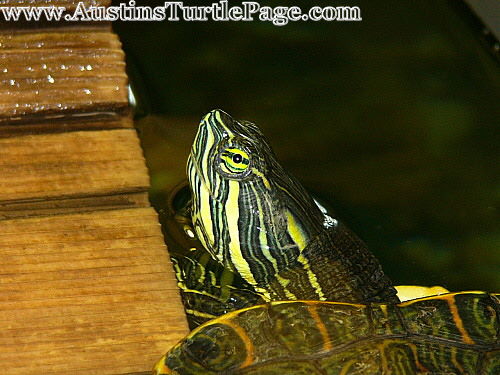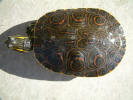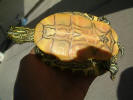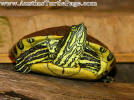|
|
|
|
|
Carapace - Carapace is oval, weakly-keeled, slightly serrated posterior rim. Vertibral 1 is longer than broad or as long as broad; other four are broader than long; carapace is olive to brown. Plastron - plastron is hingeless; hindlobe is slightly notched posteriorly. Head - .head is moderate in size with a protruding snout and medially notched upper jaw; skin is green to olive brown with yellow stripes; a yellow prefrontal arrow is formed as the supratemporal stripes pass forward from the eyes to meet a sagittal stripe on top of the snout; the neck is marked with numerous stripes and a central chin stripe runs backwards and divides to form a Y-shaped marking; limbs have numerous narrow stripes; Large, dark-centered circles on the pleural scutes, supratemporal stripe reaches the eye and the seam-following pattern on the plastron is extensive. Size - Adults can achieve a carapace length of 10" for females and 6-7" for males". |
||
|
|
|
|
|
|
|
|
Ranges from the city of Veracruz, Mexico through Honduras (including the
Yucatan Peninsula) in the Atlantic and Gulf drainages.
|
||
|
|
|
|
|
|
|
||||
|
TEMPERATURE RANGE (°F)
Tropical Sliders are not able to handle the cooler temperatures of North America, especially in the northern states and Canada . Because of this, it makes owning these turtles difficult. They get large and require a large, outdoor enclosure. The problem lies with the need to bring them inside during the cooler months. It is not advised that sliders from the tropical region (those listed on this page) are kept outside year-round because of the colder temps.
Sliders are good beginner turtles in the respect of their hardiness, however, planning for their adult sizes need to be paramount as they can be difficult to maintain as adults and just as difficult to rehome should the need arise and are therefore NOT recommended as beginner turtles. CAPTIVE DIET As in the wild, captive hatchlings and young sliders tend toward being carnivorous, although vegetation does make up a portion of their diet. As they grow older, meat plays less of a roll in their diet. In captivity, they do well on Mazuri and ReptoMin, Reptile/Pond 10, Cichlid Sticks, feeder fish, occasional ghost shrimp, aquatic plants (such as Water Lilies, Water Hyacinth, Duckweed, Anachris, Water Lettuce, Water Fern, Pondweed, Water starwort, Hornwort, Water milfoil, and Frogbit), veggies (such as Zucchini, Squash, Collard Greens, Beet Leaves, Endive, Romaine, Red Leaf Lettuce, Kale, Escarole, Mustard Greens & Dandelions) and some fruits, crickets, meal worms and blood worms. RECOMMENDED FEEDING SCHEDULE Due to the large size of both male and female sliders of all species, it is not recommended that they be kept in indoor enclosures unless these enclosures can be in excess of 125 gallons for males and 150 gallons for females (minimum). While smaller, they made me maintained in smaller enclosures, but attention to size is important for water quality, health, aggression and quality of life reasons. Adding additional sliders to a habitat requires that you increase the size of the tank accordingly by half (ie; 1 male = 125 gallons, 2 males = 190 gallons, etc).Stock tanks also make great alternatives to glass an acrylic aquariums. Sliders are aggressive baskers and as such, require a basking area where they can get completely out of the water and be able to dry off and absorb UVB lighting and heat. Habitats can be dirt, sand, gravel, smooth rocks or flat rocks, driftwood or anything that will support their weight and is non-abrasive. WATER DEPTH All species of sliders are accomplished swimmers, even as fresh hatchlings, and require deep water. COMMUNITY HABITAT Sliders make great community inhabitants with other species from the same region and other sliders as well, provided that adequate space is given. Additional males, even of other species, can be problematic in the form of aggression even in large enclosures. Sliders have powerful jaws and can easily kill smaller turtles turtles, so only turtles of comparable size are recommended. |
||||||
|
|
|
|
|
|
|
| Sliders can lay anywhere from 2 to 30 eggs at a time, dependant upon the size of the female. Incubation time lasts anywhere from 69 to 92 days at 77° - 86°F. | ||
|
|
|
|
|
|
|
|
ENCLOSURE A hatchling's captive habitat should mimic that which it would have as an adult. The requirements are the same pertaining to lighting, heat, basking and water depth. Some keepers worry that their turtle might drown in a deep water aquarium and opt to give the hatchling a shallow habitat. That is completely inaccurate. Hatchlings - even fresh day old hatchlings - do quite well in deep water. The temperature range for hatchlings and yearlings is a bit different, however, simply because of their high mortality rate. Hatchlings and yearlings should be maintained in the same range as the daytime and basking temperatures listed above, however, their water temps should be kept between 78° and 80°F. DIET Hatchlings are more carnivorous than their older counterparts. They do well on a diet of worms, fish, crickets, augmented by a quality turtle food such as Mazuri and ReptoMin. Veggies should be offered, although some hatchlings do not take to them until they are older. |
||
|
|
|



